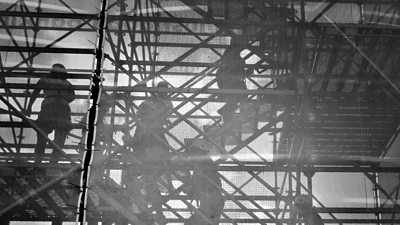Typically made of metal alloys, they come in 3 differing standards of construction, from lightweight domestic ladders, through to trade ladders and industrial ladders. Glass reinforced plastic and wooden ladders are also available.
This Guide does not apply to access using fixed vertical ladders (see our other Work at Height Guides - General & Rope Access).
What Can Go Wrong?
- Falls from height - could occur if the ladder slips, topples over, collapses or rungs break
- Struck by falling objects - the ladder or other items could be dropped onto people below
- Manual handling - you could hurt yourself manoeuvring the ladder or climbing it with a load
- Electric shock – could happen if it comes close to a live electrical conductor e.g. power lines.
Legal/�鶹�� Requirements
- Ensure work at height is properly planned and organised.
- Those involved in work at height are competent.
- Risks from work at height are assessed, and appropriate work equipment is selected and used.
- The risks of working on or near fragile surfaces are properly managed.
- Equipment used for work at height is properly inspected and maintained.
Control Measures
Planning your work at height
- Through risk assessment, decide if a ladder is the most suitable means of access – they should only be used for short duration work (<30mins in any one location), when carrying light loads (<10kg), when they can be positioned safely and not when it’s windy, very cold or wet
- Check that workers are physically fit and confident working at height
- Ensure the ladder is the right type, size & class of construction – except for the simplest tasks, try avoid using lightweight domestic ladders
- Ensure the ladder is subject to routine thorough inspections by a competent person (typically every 12 months) - ladders should not be painted (which could hide any faults e.g. cracks / splits), They shouldn't have temporary repairs and should be stored/ transported in a way to minimise damage
- Check access and conditions will be suitable for ladder use i.e. even/ stable ground, suitable structure to rest ladder on, room to manoeuvre the ladder, no exposed electrical conductors.
- Minimise the distance any ladder needs to be carried and for a larger extendable ladders, ensure two fit people will be available to carry & position it.
Using portable ladders
- Carry out a quick visual inspection before use to ensure the ladder has no obvious defects
- Maintain an exclusion zone around the base of the ladder – take steps to warn or prevent people or vehicles coming close
- User to wear flat-soled shoes or boots with good grip
- Users should face forward and avoid over-reaching (i.e. keep your naval within the stiles) or applying such force to the task to cause them to overbalance themselves
- Use a haul line, shoulder bag or belt hooks to carry equipment you might otherwise drop.
Single and extension ladders only
- Position the ladder at an angle of approx. 75° (1 metre out for every 4m up) against a solid structure
- For an extension ladder, make sure that there is at least 3 rungs of overlap between sections
- Where possible, tie upper rungs or stiles to the structure to prevent the ladder slipping or toppling – having a second person to ‘foot the ladder’ is a quick but far less secure alternative
- If the ladder is being used to provide access to a roof or other platform and no other suitable handholds are available, ensure the ladder extends at least 1m beyond platform level
- Maintain 3 points of contact with the ladder at all times – if two handed work is required, a work restraint belt and lanyard should be used to provide a ‘third hand'.
Step-ladders only
- Ensure the ladder is fully extended, with leg brackets locked into place
- Ensure the ladder is on firm level ground, with top platform horizontal
- Do not climb up as high as the top few steps
- Both hands may be used to carry out a task provided the step-ladder is stable and the body can be rested against some part of the ladder to maintain stability.
Division Specific Issues
- Incorporating Radio OB MS M013-09 Using Ladders & Step Ladders.
FAQs/Did You Know?
- A place is 'at height' if you could be injured falling from it, even if it is at or below ground level.
- Approx. one third of all reportable 'fall from height' accidents in the workplace involve portable ladders, accounting for approx.14 deaths and 1200 major injuries each year.
Recommended links
Working at Height topics
-

General
Guidance to assist planning, conducting or managing staff who are working at height -

Gantries & High Level Platforms
Guidance on media positions within stadiums and arenas -

Ladders
Guidance on ladders to work up to approx. 6m high -

Ladder Pods
Guidance on ladder pods to work up to 5m high -

Mobile Elevating Work Platforms
Guidance on mobile elevating work platforms (MEWP) such as cherry pickers and scissor lifts. -

Rope Access Techniques
The equipment and techniques required to protect those working at or near exposed drops. -

Ropes Riggers: Selection of
Competence criteria for the various professional Ropes Riggers. -

Tower Scaffolds
Guidance on tower scaffolds to work up to approx 8m high
More from SSR
-
Your platform to record accidents, risk assessments, assurance monitoring and inspections
-
Safety Equipment Stores
Just one number to call: 020 3614 5155 -
�鶹�� Safety Guidelines
An A-Z of �鶹��'s Health and Safety Guidelines -
Safety Advice Line: 0370 411 0464 Email: safety@bbc.co.uk
Events guidance - key links:
- Exhibitions
- General Guidance
- Indoor Location Recce Checklist
- Outdoor Location Recce Checklist
- Major Incidents & Emergency Planning
- Marketing and Promotional
- Noise Exposure
- Planning and Management
- Responsibilities
- Responsibilities Form
- Laser Lighting Effects
- Strobe Lighting
- Temporary Stages and Rostra
Health topics - key links:
- (�鶹�� network only)
- Contributors Fitness to Participate
- Display Screen Equipment (DSE)
- (�鶹�� network only)
- First Aid and Welfare on Location
- International Travel - Risks & Health
- Manual Handling
- Mental Health: Homepage
- (�鶹�� network only)
- Personal Health and Wellbeing
- Pregnancy
- Psychological Trauma Support & Trauma Risk Management (TRiM)
- Tiredness and Fatigue
- Travel Health Contacts
�鶹�� High Risk - key links:
- CBRN and Industrial Spills
- Covert Filming
- Crisis Management and Security Support
- Demonstrations, Protests and Crowds
- Disaster Coverage
- Door Stepping
- (�鶹�� network only)
- (�鶹�� network only)
- Public Order
- Safety Equipment Stores
�鶹�� Journalism - key links:
�鶹�� Productions - key links:
- Aerial Filming and Airfields
- Animals: Displaying and handling for performance
- Boats: Working on
- Children and Young People
- Driving
- Electrical Equipment and Systems
- First Aid and Welfare on Location
- Food Safety (Cooking and Catering)
- Remote Location Working
- Roads and Streets: Working by
- Security of Productions on Location
- Stunts
- Tiredness and Fatigue
- Unmanned Aerial Systems (UAS aka Drones)
- Vehicles: Recording in, from and around
- Working at Height: Mobile Elevating Work Platforms
- Working at Height: Tower Scaffolds
�鶹�� Radio - key links:
- (�鶹�� Network only)
�鶹�� Security - key links:
�鶹�� Sport - key links:
About this site
This site describes what the �鶹�� does in relation to managing its health, safety and security risks and is intended for those who work directly for the �鶹��.
It is not intended to provide instruction or guidance on how third parties should manage their risks. The �鶹�� cannot be held liable for how this information is interpreted or used by third parties, nor provide any assurance that adopting it would provide any measure of legal compliance. More information
Some links on this site are only accessible when connected to the �鶹�� network

